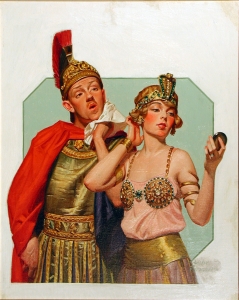
Leslie Thrasher (1889-1936)|I’m Dying, Egypt, Dyin.|Cover illustration for Liberty (April 23, 1927)|oil on canvas|Delaware Art Museum, gift of Mrs. Audrey Thrasher de Russow, 1973-16
Like other popular mass-circulation weekly magazines, Liberty, established in 1924, tried out a variety of cover designs until it hit on the creation of a visual running story-line to keep audiences returning week after week to see the next segment of the story. They called this the “continuity cover.”In 1926 Liberty contracted Leslie Thrasher to create a serialized sequence of cover illustrations paying the artist $ 1,000 for each cover. Liberty magazine even invited its readers to contribute plot and picture ideas for the serial covers. And each cover had a page-long related text in the magazine. The six-year succession of Thrasher’s weekly covers told the story of the courtship and eventual marriage of the middle-class couple Lil Morse and Sandford Jenkins. Like most families the story expanded including Lil and Sandy’s extended family and their son, Ulysses. The concept was extremely successful and continued through 1932.In the painting for the April 1927 Liberty cover Sandy and Lil prepare for a costume party dressed as the ill-fated Shakespearean lovers, Anthony and Cleopatra. In his obvious discomfort, Sandy mocks one of Mark Anthony’s last lines to Cleopatra, said as the Roman Guard bear his stretcher:
“I am dying, Egypt, dying; only
I here importune death awhile, until
Of many thousand kisses the poor last
I lay up thy lips.”
And a few lines later,
“I am dying, Egypt, dying:
Give me some wine, and let me speak a little
“Thrasher’s painted rendition of the costume’s materials is wonderfully realistic and Sandy’s discomfort is obvious. Sandy stands for every put-upon man attempting to satisfy his girl-friend. Pretty Lil ignores Sandy’s complaint as she seriously admires herself. And while it is Sandy’s use of Shakespeare’s words that is suppose to supply the humorous response it is the incongruity of Lil’s simple pink camisole juxtaposed with the “jewel” studded brassiere which causes us to do a double-take.
Charles Leslie Thrasher was a classically-trained artist having studied at the Pennsylvania Academy of the Fine Arts in Philadelphia and the Ecole des Grande Chaumiere in Paris. In 1910 he moved to Wilmington, Delaware to continue his studies with the illustrator Howard Pyle. There he shared a studio with fellow students Eads Collins and Douglas Duer. Thrasher’s first published magazine cover was in 1912 for The Saturday Evening Post, who paid him $50 for his work.While Liberty had a smaller circulation than the weeklies The Saturday Evening Post or Collier’s, many of its story lines, including Thrasher’s sequential covers, took on a second life in other media. For example, feature length films such as “Sergeant York” and “My Man Godfrey” were adapted from stories printed in the pages of Liberty magazine. Sandy and Lil were so popular that soon they became characters in a radio soap opera and eventually characters in the movie, For the Love ‘o Lil, 1930 produced by Columbia Pictures.
June 19, 2009
Joyce K. Schiller, Curator, Rockwell Center for American Visual Studies
Norman Rockwell Museum






